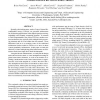Free Online Productivity Tools
i2Speak
i2Symbol
i2OCR
iTex2Img
iWeb2Print
iWeb2Shot
i2Type
iPdf2Split
iPdf2Merge
i2Bopomofo
i2Arabic
i2Style
i2Image
i2PDF
iLatex2Rtf
Sci2ools
FPL
2009
Springer
2009
Springer
Static versus scheduled interconnect in Coarse-Grained Reconfigurable Arrays
Spatially-tiled architectures, such as Coarse-Grained Reconfigurable Arrays (CGRAs), are powerful architectures for accelerating applications in the digital-signal processing, embedded, and scientific computing domains. In contrast to Field-Programmable Gate Arrays (FPGAs), another common accelerator, they typically time-multiplex their processing elements and are word rather than bit-oriented. These differences lead us to re-examine some of the traditional architecture choices made for FPGAs as we move to these coarser-granularity architectures. In this paper we study the efficiency of time-multiplexing global interconnect as architectures scale from single-bit to multi-bit datapaths. Using the Mosaic infrastructure, we analyzed the design trade-offs involved in static vs. time-multiplexed routing for global interconnect channels, as well as the benefit of including a dedicated bit-wide control interconnect to supplement the word-wide datapath of a CGRA. We show that a time-multi...
| Added | 24 Jul 2010 |
| Updated | 24 Jul 2010 |
| Type | Conference |
| Year | 2009 |
| Where | FPL |
| Authors | Brian Van Essen, Aaron Wood, Allan Carroll, Stephen Friedman, Robin Panda, Benjamin Ylvisaker, Carl Ebeling, Scott Hauck |
Comments (0)

